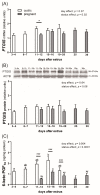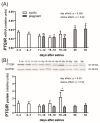Prostacyclin Synthesis and Prostacyclin Receptor Expression in the Porcine Myometrium: Prostacyclin Potential to Regulate Fatty Acid Transporters, Cytokines and Contractility-Related Factors
- PMID: 36077955
- PMCID: PMC9454576
- DOI: 10.3390/ani12172237
Prostacyclin Synthesis and Prostacyclin Receptor Expression in the Porcine Myometrium: Prostacyclin Potential to Regulate Fatty Acid Transporters, Cytokines and Contractility-Related Factors
Abstract
Although prostacyclin (PGI2) has been well described as a regulator of smooth muscle activity, limited data are available concerning its role in the myometrium of pigs. The present research aimed to examine profiles of PGI2 synthase (PTGIS) and PGI2 receptor (PTGIR) expression and 6-keto PGF1α (a PGI2 metabolite) concentrations in the myometrium of gilts throughout the estrous cycle and during early pregnancy using qPCR, Western blot, and/or ELISA methods. Furthermore, myometrial explants were exposed to iloprost (a stable PGI2 analog) to investigate the effect of PGI2 on the mRNA expression of factors engaged in smooth muscle contraction, nutrient transport, prostaglandin synthesis and action, and inflammatory response. PTGIS mRNA expression was greater in cyclic than in pregnant gilts on days 11-12 after estrus and was accompanied by greater concentrations of 6-keto PGF1α detected in cyclic than in pregnant animals on days 11-20. Iloprost stimulated fatty acid transporters and contractility-related calponin 1 and caldesmon 1 mRNA expression and decreased interleukin 1β and tumor necrosis factor transcript abundance. The obtained results indicate a physiologically relevant role of PGI2 during the estrous cycle in the porcine myometrium with its importance for regulating the expression of contractility-, nutrient transport- and inflammatory response-related factors.
Keywords: contractility-related factors; cytokines; myometrium; nutrient transporters; pig; pregnancy; prostacyclin; prostacyclin receptor; prostaglandin receptors; the estrous cycle.
Conflict of interest statement
The authors declare no conflict of interest.
Figures




Similar articles
-
Prostacyclin receptor (PTGIR) in the porcine endometrium: Regulation of expression and role in luminal epithelial and stromal cells.Theriogenology. 2015 Oct 1;84(6):969-82. doi: 10.1016/j.theriogenology.2015.05.034. Epub 2015 Jun 6. Theriogenology. 2015. PMID: 26139576
-
Expression profile and role of prostacyclin receptor (PTGIR) in peri-implantation porcine conceptuses.Theriogenology. 2014 Sep 1;82(4):546-56. doi: 10.1016/j.theriogenology.2014.05.014. Epub 2014 May 21. Theriogenology. 2014. PMID: 24954635
-
Cyclic mechanical stretching and interleukin-1alpha synergistically up-regulate prostacyclin secretion in cultured human uterine myometrial cells.Gynecol Endocrinol. 2004 Mar;18(3):130-7. doi: 10.1080/09513590410001667850. Gynecol Endocrinol. 2004. PMID: 15255281
-
Ovarian stimulation with human chorionic gonadotropin and equine chorionic gonadotropin affects prostacyclin and its receptor expression in the porcine oviduct.Domest Anim Endocrinol. 2015 Oct;53:17-25. doi: 10.1016/j.domaniend.2015.04.002. Epub 2015 Apr 16. Domest Anim Endocrinol. 2015. PMID: 26069941 Clinical Trial.
-
Biochemistry of myometrial contractility.Baillieres Clin Obstet Gynaecol. 1992 Dec;6(4):755-69. doi: 10.1016/s0950-3552(05)80187-7. Baillieres Clin Obstet Gynaecol. 1992. PMID: 1335853 Review.
References
-
- Paria B.C., Song H., Dey S.K. Implantation: Molecular basis of uterine dialogue. Int. J. Dev. Biol. 2001;45:597–605. - PubMed
Grants and funding
LinkOut - more resources
Full Text Sources

